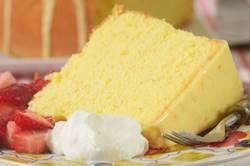|
 The
two methods for producing foam cakes are: The
two methods for producing foam cakes are:
1)
Separated Egg Method (sponge,
angel food,
biscuit,
roulade,
chiffon,
meringue,
dacquoise)
2) Whole Egg Method (genoise)
The main difference between foam cakes and butter cakes is baking
powder/soda is not used for leavening (rise) in foam cakes.
Both foam cake methods use beaten eggs to give the cake volume, not a chemical leavener as in butter cakes.
When the eggs are beaten air cells form in the batter and these cells
will expand in a
hot oven giving the cake its volume and structure. To make sure
the beaten eggs reach their full volume, it is
important they are fresh, the correct size and at room temperature.
Separating Eggs: Cold eggs are
easier to separate but room temperature eggs give more
volume when beaten. Therefore, separate the eggs when they are cold and then cover the egg whites and yolks with
plastic wrap (prevents yolks and whites from drying out) and bring to room temperature (takes about 30 minutes)
before using.
To separate an egg: Have two small bowls ready. Over one
bowl, break
the egg in half and allow the egg white to fall
into the bowl as you carefully transfer the egg yolk back and forth
between the two halves of the shell. When the egg white has
completely separated from the yolk, put the yolk in the second bowl.
If separating another egg, start with a clean (third) bowl for the new egg
white, so if you get some yolk in the egg white bowl
you don't contaminate the first white. The whites will not
whip
properly if there is any yolk in them. (To remove yolk; take an empty egg shell and dip it into the
white where the yolk is. The yolk will be attracted to the
shell.) Another method is to crack the egg
and then place the egg in your cupped hand. Separate your
fingers and let the white run through your fingers into a bowl.
Place the yolk in another bowl.
The separated egg method is the most common and some recipes use
both the egg yolks and whites
(sponge), while others only use the
egg whites (angel food, meringue).
Egg
yolks are beaten with most (a little is used when
whipping the whites)
of the granulated white sugar (superfine or castor produces a finer textured cake and
a smoother meringue) until the mixture is thick and lemon
colored (takes about 5 minutes). Beating creates tiny air cells
which expand when the batter is placed in a hot oven.
In
a clean bowl, whip the egg whites with a little sugar to produce a
meringue. Start on low speed to break
the whites up. When a foam appears on the whites, add the
cream of tartar (approximately 1/8 teaspoon for every two
large egg whites). (When whipping the whites, cream of tartar (acid) is
used to stabilize them and helps the whites reach full volume.) Gradually increase the speed to medium-high until almost stiff and then add the sugar in a steady stream until
the whites are stiff, but not dry. (Should be thick and
shiny.)
The
egg whites and flour are then gently folded into the egg yolk mixture
(using a whisk or rubber spatula), taking care not the deflate the
batter. Gently pour the batter into the prepared pan (as per your
recipe) and smooth using an offset spatula. Bake as instructed
in your recipe.
Angel Food Cake,
Meringues, and
Dacquoise use only egg whites and
contain no fat (butter or egg yolks).
Chiffon Cakes use the
separated egg method and contain oil and baking powder.
Genoise (French butter sponge cake or European sponge cake)
uses the
whole egg method. The genoise uses whole eggs instead of separated eggs
(sponge) and
contains butter which makes a very flavorful and tender genoise.
It is not as sweet as the sponge cake because it contains less sugar.
Because it can be dry, a syrup is sometimes used to moisten the cake
layers and this gives the genoise added flavor as well as a soft and
tender crumb. Additional flavorings can be added to a genoise
batter, such as extracts, liqueurs, citrus zest, and finely ground nuts.
To
make a genoise put the eggs and sugar in a
metal bowl over a saucepan of warm water (double boiler) and heat until the egg and sugar mixture reaches
approximately 100 degrees F (40 degrees C). (Heating the eggs and
sugar first dissolves the sugar so the mixture will reach its
maximum volume when whipped.) Remove from the
water bath and beat
until thick and cool (about five minutes) (the batter will become
lighter and paler in color as it thickens - usually starts out yellow
and ends up cream colored). The flour, and sometimes cornstarch,
are gently folded in using a wire whisk or spatula and then melted
butter (clarified butter is often used which adds a nice distinctive
flavor) is added. To best way to do this is to first add a little
batter to the melted butter, to lighten it, and then fold this mixture
back into the batter. This will prevent deflating the batter.
Pour batter into the prepared pan (buttered and floured and lined with
parchment paper, which is buttered and floured) and bake (according to
your recipe's directions).
Genoise is often used as a component for other desserts, such as a
Gateau.
(Gateau
or gateaux
is an elegant French layer cake). The genoise is baked in a round
cake pan, cooled, and sliced into two or more layers. The layers are brushed with a flavored sugar syrup or liqueur syrup and filled with
buttercream, pastry cream, or whipped cream. The tops and sides
are frosted and decorated with nuts, fruit, etc.
|